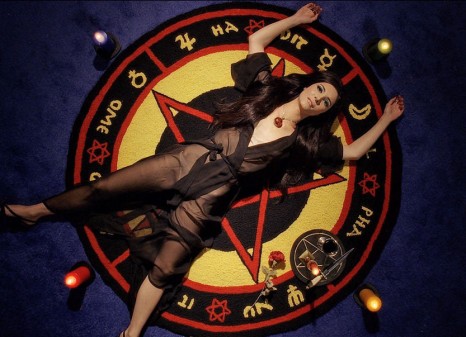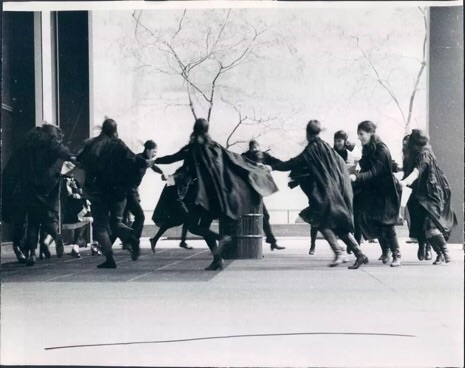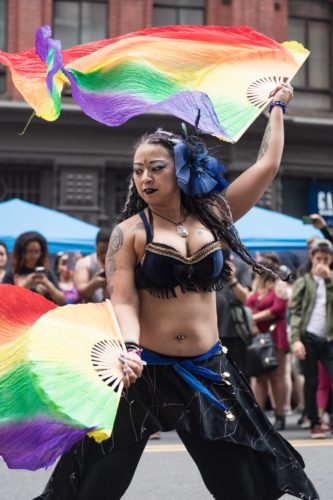TWH – The conservative media outlet Breitbart published an article Dec. 17 titled #MagicalResistence: the Rise of Feminist Witchcraft. Since posting, the article has gone viral, earning 5,087 comments and attracting the attention of other media outlets and the Pagan online community.
“From organizing mass hexes to setting up witch-themed Etsy stores, the feminist movement and witchcraft are becoming increasingly entwined,” observes Breitbart writer Charlie Nash.
“The two scenes have become so intertwined that the term ‘witch has even started to become synonymous with ‘feminist.'”

Still from the film The Love Witch [Anna Biller].
He continues, “Secondly, I think it scares religious people. Obviously, a lot of these people are atheistic. They like to wind up the Christians. And thirdly, I think they also have a kind of—they feel like they have a connection to the persecuted women of the Salem witch trials. They look at these women and see them as kind of as victims of patriarchy, almost.”
Marlow asked whether he thought Trump was responsible for a rise in occultism or the practice of Witchcraft. With hesitation, Nash says that he thinks so. He notes that a member of the Church of Satan called these times an “occult renaissance,” and the rise in Witchcraft practice is due to increased “hardships and cultural strife.”
While Nash did reportedly look at the current online trends, the vast majority of his original article is simply quotes taken from a long essay by feminist writer Laurie Penny, who looked closely at the current rise in trendy Witchcraft. On Dec. 13, Penny wrote:
Today, witchcraft is back in vogue, a heady brew of nineties nostalgia, goth revivalism and plain, arcane fun sloshing around social media. Days after Donald Trump won the U.S. election, videos of women “hexing” Trump went viral around the world, encouraging budding magical practitioners to burn images of the president-elect to bring his works to ruin. Meanwhile, an entire explosive industry of witch-paraphernalia is boiling out of the cauldron of digital consumer culture.
Penny attempts to examine and disambiguate the practice of Witchcraft as a reality from the purely cultural aesthetic, the online teen trends, Paganism as spiritual practice, and feminist politics. Her essay is a long musing that winds down various roads, sometimes aimlessly and sometimes not.
Regardless on whether one agrees with her or not, Penny’s in-depth discussion is written from a personal perspective, having once participated in Witchcraft and chaos magic herself. She did did her research and even interviews former Wild Hunt columnist and Treadwell book shop owner Christina Oakley-Harrington, who Penny says “knows what she’s talking about.”
While Penny expresses reservations when it comes to the sincerity of Witchcraft practice and the viability of magic, she concludes, “Traditionally, witches did not do magic in order to rule the world, or damn it. Witches worked in their communities for the common good, as well as their own. Witches took control of their own destinies and helped others do the same—and there’s danger whenever a woman decides to do that, whatever the cost, no matter what she calls it. The magic might not be “real”—but it works anyway.”
Penny fully embraces the role the Witch archetype plays in feminism, and the acceptance of Witchcraft as part of feminist rhetoric. She acknowledges the rich history of the Witch archetype being used openly as a stand-in for the strong, empowered woman.
It would seem that this is something Breitbart writers have just figured out.

1969 WITCH protest in front of Chicago Federal Building [WITCH].
However, counter to Penny’s article, commodification did not kill the movement, nor did it kill the one in the 1990s. Commodification and our contemporary consumer-driven culture fuel most pop culture fads.
Regardless, trendy Witchcraft comes and goes partly based on, what Nash suggests, “hardship” and “cultural strife.” The trend ends when society shifts. By the late 1970s the energy crisis and the coming conservative era with its increasing fear of Satanic practice killed the pop-culture trend. Later in the 1990s, the teen Witchcraft fad was most likely killed by the shock of Sept. 11, a wake-up call of sorts, and the dawn of a new post-9/11 era.
Pop cultural trends don’t have deep roots, so they come and go with the fickle winds of societal interests. However, in all cases, these trends do leave a mark, even if it’s only in an awareness or acceptance of magical concepts and the more typically hidden occult subcultures.
In both of those past decades, after the winds shifted and the dust settled, there were still Witches practicing in their homes, with their covens and families. Since the 1960s, the Pagan population has grown significantly and also diversified. While the fads might not last and every empowered person, man or woman, might not forever identify as a Witch, some do stay.
What Nash missed in Penny’s original article and in his general analysis is that Witchcraft is not “becoming increasingly entwined with feminism.” It has always been there, even since first-wave feminism. It has also long been part of other forms of political and social activism, even before the 20th century.
While it is true that, since 2013, the pop-culture Witchcraft fad has been increasing or trending, this is not the first time we’ve seen such an upswing. Additionally, the residual effects of those past movements are still being felt today, most notably in the increased growth and acceptance of the varied Pagan, Heathen, and polytheist religious practices and even in the general social acceptance of the current fad.
In 1970, Witchcraft was still a part of counterculture, even as a fad. In 2017, occult-related products, as Penny notes, have been commodified in mall stores and used as inspiration for clothing lines.
Another difference in today’s pop culture trend from those of past decades is the introduction of the internet, which makes ideas and concepts travel faster across distances, more accessible, and even potentially seem more popular than it actually is. The internet super-sizes culture.
Group hex actions are easier to organize, easier to publicize, and we are more aware of them as a society. Are there more than there were? Probably not, as a percentage of the population.
With that said, Witchcraft is, for better or worse, trending in American pop culture; there is no doubt about that point. Nash is correct. As in the past, the trend will fade as do all trends.
However, contrary to Nash’s assumption, the practice of Witchcraft today is far more than just “mischievous laughing” and wanting to troll religious or political conservatives. For many, it is a lifestyle, a religious belief system, a way of thinking, a path that guides them through life, whether that be quiet contemplate or political action or anything in between.

WitchsFest2016 [Ron Frary].
In consideration of the Witch archetype’s history of being a symbol of female empowerment. particularly in times of strife, the Witch almost seems to have become her own magical egregore, if you will. For many men and women, she is represents the empowered person and the survivor against all odds, one who is both feared and celebrated. Every time she is called upon, even if it is in a Target store, on Etsy, or in a magical circle, her power grows and shifts, and that ultimately benefits everyone and anyone who identifies, even for one day, as a Witch.
Marlow ends the podcast conversation by asking Nash where this trend will ultimately lead, expressing concerns about future animal and baby sacrifices. While the current fad will eventually end leaving some new imprint on contemporary society, the “when” is unknown. Perhaps it will fade when Trump is no longer president, since that seems to be, in part fueling it. Perhaps not, but it will end.
Regardless of that ebb and flow, modern Witches and other magical practitioners will remain well beyond the death of the current Witch fad, and they will continue to do their magic, as they always have.
The Wild Hunt is not responsible for links to external content.
To join a conversation on this post:
Visit our The Wild Hunt subreddit! Point your favorite browser to https://www.reddit.com/r/The_Wild_Hunt_News/, then click “JOIN”. Make sure to click the bell, too, to be notified of new articles posted to our subreddit.